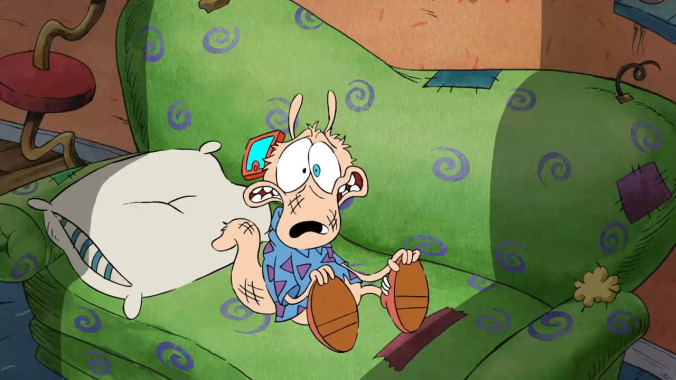In reality, Rocko’s Modern Life was an audacious, wild, slice-of-life show that explored the complexity of living as a twentysomething through issues both mundane—like laundry day or credit-card debt—and serious, like adoption or immigration. Rewatching the final four Rocko’s Modern Life episodes ahead of Static Cling, you’re struck by how blunt it could be when it came to its satirical voice; the last episode aired, “Floundering Fathers,” (as opposed to the produced last episode “Future Schlock,” on which Static Cling is following up) has a moment where Rocko is excluded from a patriotic parade event because he’s “a foreigner.” It’s that kind of juxtaposition—of frustrating, minor issues butted up against more serious, complicated ones, all while functioning in an absurdist setting—that showcases Static Cling as a smarter and more powerful, more resonant piece of satire than the show’s overall reputation.
Don’t worry, though—Static Cling maintains the original show’s look, sound, and aesthetic perfectly (although Philbert appears a bit off-model at times). It takes a moment to get reacquainted with the show’s energy and pacing, which is a bit slower and more easygoing than one might remember, but by the time Rocko, Heffer, and Philbert land back in O-Town, you’ll feel right at home. Rocko himself is still the adorable ball of anxiety that graced TV screens years ago, and while over the course of that iteration he had grown into a more assertive version of himself, Static Cling utilizes a solid explanation to revert him somewhat back to his old, nervous self. Being trapped in space watching the same episode of The Fatheads over and over gave the wallaby a certain level of comfort and familiarity, a stable visual to keep his sanity after all these years. To land back in 201X, and to be completely overwhelmed by the significant changes in technology, lifestyles, and social relationships has Rocko desperately clinging to the familiar comforts that The Fatheads provided. But when he learns that show was canceled years ago, he goes off to do what he can to try to bring the show back—to “reboot” it.
Yes, Static Cling pokes delightful fun at itself and its existence, utilizing the “rebooting old property” concept to make some solid, if easy, jabs at the soulless, corporate nature behind most reboots and the idea of pop culture nostalgia as a spurious crutch upon which meaning and purpose can be placed. (One chyron during a newscast reads “90’s Cartoon Solves Problem$,” the dollar sign adding an extra wink). But it also uses the theme of encountering and embracing change to explore some pretty powerful, relevant modern-day issues. As reported, there is indeed a significant trans storyline that centers on Rachel Bighead, the daughter of Ed and Bev Bighead, who was introduced in the original series as Ralph Bighead in the season-two episode, “I Have No Son.” Static Cling doesn’t get into the story of her transition, so don’t expect a deep exploration of her past; but she still is a real, filled-in character whose return and reveal tests the comfort levels of her father. It’s all handled respectfully, and even provides a surprising emotional connection between Rocko and Ed, the two who struggle the most within this setting of change and transition.
Everything else is still intact, from the distinct, stylistic curvatures of the buildings and landscape, to the unique and downright nutty Fleischer-esque randomness that always provide a (slightly disturbing) laugh. Rocko’s still has that distinctive purple/orange/off-green color palette and Pat Irwin’s smooth, somewhat discordant jazzy score. And yes, it still has its share of blue gags, particularly about a certain dog and his enjoyment of mops. But most importantly, Static Cling brings its trivial-to-thoughtful narrative possibilities fully to the forefront. If there are flaws, they’re in the ending, which feels rushed and cluttered in a way that fails to really explore a meaningful way for Rocko to find a more emotional, grounded way to sustain himself in this new O-Town. But perhaps such a direct skewering would be a bit too much for the eager audience champing at the bit to see the familiar, triangle shirt-wearing wallaby again. Besides, that’s the mundane stuff. The more genuine storyline that’s explored is a much more significant piece worthy of consideration, so much so that it’s worth re-evaluating Rocko’s Modern Life as a whole.



 Keep scrolling for more great stories from A.V. Club.
Keep scrolling for more great stories from A.V. Club.